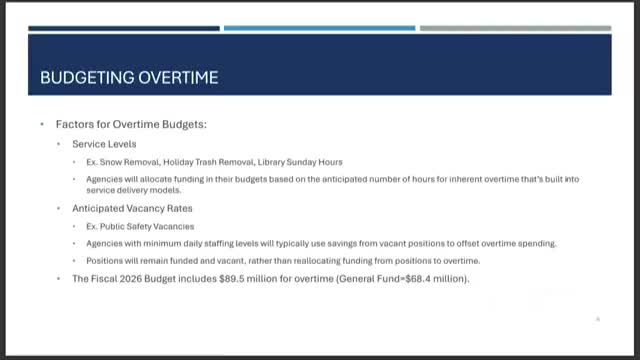City reallocates $33M for overtime amid 1,600 vacant positions in police and fire departments
May 25, 2025 | Baltimore City, Baltimore County, Maryland
This article was created by AI summarizing key points discussed. AI makes mistakes, so for full details and context, please refer to the video of the full meeting. Please report any errors so we can fix them. Report an error »

The Baltimore City Council's recent Committee of the Whole meeting highlighted significant staffing challenges within the city's fire and police departments, revealing a pressing need for effective recruitment strategies. As of May 2025, over 2,700 positions remain vacant across city agencies, with more than 1,500 of these funded by the general fund. Alarmingly, 554 of these positions have been unfilled for over 18 months, raising concerns about the efficiency of city operations and the impact on public safety.
The discussion centered on the ongoing struggle to fill these vacancies, particularly in the police and fire departments, which account for a substantial portion of the unfilled roles. The city has budgeted approximately $89.5 million for overtime in the upcoming fiscal year, with $68.4 million sourced from the general fund. This reliance on overtime is a direct response to the staffing shortages, as city officials noted that service levels have remained constant despite the increasing number of vacancies.
City officials explained that many of the vacant positions are classified as "phantom positions," meaning that while they are budgeted, they have not been filled for an extended period. The funds allocated for these roles are often redirected to cover overtime costs, particularly in the police and fire departments, where the need for personnel remains critical. The meeting underscored the importance of addressing these vacancies to ensure that public safety services are not compromised.
In response to the staffing crisis, the city is implementing new recruitment initiatives aimed at increasing the number of police officers and firefighters. The police department is currently experiencing one of its largest recruitment classes, a move intended to reduce the number of vacancies and improve service delivery.
The meeting concluded with a call for continued focus on recruitment and retention strategies to address the ongoing staffing challenges. As the city prepares for the next fiscal year, the outcomes of these discussions will be crucial in shaping the future of public safety and city services in Baltimore.
The discussion centered on the ongoing struggle to fill these vacancies, particularly in the police and fire departments, which account for a substantial portion of the unfilled roles. The city has budgeted approximately $89.5 million for overtime in the upcoming fiscal year, with $68.4 million sourced from the general fund. This reliance on overtime is a direct response to the staffing shortages, as city officials noted that service levels have remained constant despite the increasing number of vacancies.
City officials explained that many of the vacant positions are classified as "phantom positions," meaning that while they are budgeted, they have not been filled for an extended period. The funds allocated for these roles are often redirected to cover overtime costs, particularly in the police and fire departments, where the need for personnel remains critical. The meeting underscored the importance of addressing these vacancies to ensure that public safety services are not compromised.
In response to the staffing crisis, the city is implementing new recruitment initiatives aimed at increasing the number of police officers and firefighters. The police department is currently experiencing one of its largest recruitment classes, a move intended to reduce the number of vacancies and improve service delivery.
The meeting concluded with a call for continued focus on recruitment and retention strategies to address the ongoing staffing challenges. As the city prepares for the next fiscal year, the outcomes of these discussions will be crucial in shaping the future of public safety and city services in Baltimore.
View full meeting
This article is based on a recent meeting—watch the full video and explore the complete transcript for deeper insights into the discussion.
View full meeting
